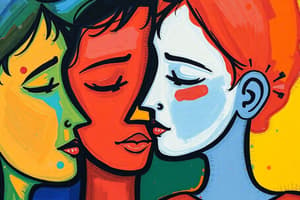Podcast
Questions and Answers
What is the primary characteristic of Autism Spectrum Disorder?
What is the primary characteristic of Autism Spectrum Disorder?
- Difficulty with communication and social interactions only
- Difficulty with verbal and non-verbal communication, social interactions, and restricted behaviors (correct)
- Difficulty with emotional regulation and behavioral difficulties
- Hearing impairments and language disorders
What is the primary goal of strategies for effective communication?
What is the primary goal of strategies for effective communication?
- To diagnose language disorders
- To adapt to individual communication styles and needs (correct)
- To improve hearing impairments
- To treat speech disorders
What is the typical age of diagnosis for Autism Spectrum Disorder?
What is the typical age of diagnosis for Autism Spectrum Disorder?
- By age 5
- By age 7
- By age 3 (correct)
- By age 1
What is a characteristic of Emotional and Behavioral Difficulties (EBD)?
What is a characteristic of Emotional and Behavioral Difficulties (EBD)?
What is a cause of Emotional and Behavioral Difficulties (EBD)?
What is a cause of Emotional and Behavioral Difficulties (EBD)?
What is a strategy for effective communication?
What is a strategy for effective communication?
What is the importance of early identification and intervention for Emotional and Behavioral Difficulties (EBD)?
What is the importance of early identification and intervention for Emotional and Behavioral Difficulties (EBD)?
What is a treatment for Autism Spectrum Disorder?
What is a treatment for Autism Spectrum Disorder?
What is a characteristic of communication disabilities?
What is a characteristic of communication disabilities?
What is the primary purpose of behavioral therapy for Emotional and Behavioral Difficulties (EBD)?
What is the primary purpose of behavioral therapy for Emotional and Behavioral Difficulties (EBD)?
Flashcards are hidden until you start studying
Study Notes
Autism
- Autism, also known as Autism Spectrum Disorder (ASD), is a neurological and developmental disorder that affects communication, social interaction, and behavior.
- Characterized by:
- Difficulty with verbal and non-verbal communication
- Difficulty with social interactions and relationships
- Restricted and repetitive behaviors, interests, or activities
- Spectrum disorder: symptoms and severity vary widely among individuals
- Causes: still unknown, but research suggests genetic and environmental factors
- Diagnosis: typically made by age 3, through observation, medical history, and diagnostic tests
- Treatment: early intervention, behavioral therapy, medication, and educational support
Communication
- Communication is a fundamental aspect of human interaction, essential for social, emotional, and cognitive development
- Communication disabilities:
- Speech disorders: difficulty articulating sounds, words, or sentences
- Language disorders: difficulty understanding, processing, or using language
- Hearing impairments: partial or complete loss of hearing
- Strategies for effective communication:
- Active listening
- Clear and concise language
- Use of visual aids, gestures, and assistive technology
- Adaptation to individual communication styles and needs
Emotional and Behavioral Difficulties (EBD)
- EBD refers to a range of difficulties that affect a person's emotional and behavioral well-being
- Characteristics:
- Difficulty regulating emotions
- Impulsive or aggressive behavior
- Difficulty with social relationships and interactions
- Struggles with self-esteem and confidence
- Causes: often complex and multi-factorial, including genetic, environmental, and social factors
- Interventions:
- Behavioral therapy and counseling
- Social skills training
- Emotional regulation strategies
- Educational support and accommodations
- Importance of early identification and intervention to prevent long-term consequences
Studying That Suits You
Use AI to generate personalized quizzes and flashcards to suit your learning preferences.




